“Teach a child to read, and keep that child reading, and we will change everything. And I mean everything.”
These words, from author Jeanette Winterson, echoed through my mind earlier this year as I searched for inspiration. You see, I was trying to think of a vision for our new library at Halberton Primary School.
What sort of special environment could we create for our children, to encourage them to read and to keep them reading? I had never done anything like this before. I contacted a library design company and asked them to inspire me with their ideas. To say that I was underwhelmed at their response would be an understatement. I knew we could do better. So here is the story of how a small team created “Shirley’s Library”.
Inspiration
The spark came when I saw a picture of some wooden shelving at a local bookstore, Liznojan. It looked great – natural, ethical and sustainably sourced. I wondered if it would be possible to create a library based around these themes.
So I created a woodland-themed library inspiration board and invited parents to get involved – and I was delighted when interest was shown, particularly by a parent and member of the Liznojan team. We created an action plan and a library working group was formed where we thrashed out a draft timetable for our vision to become a reality.
Funding
We successfully received in excess of £5,000 for our library from local trusts and our PTFA. I believe that our vision to create an environment in tune with nature and being mindful of ethically sourcing materials definitely appealed to the trusts we applied to, as well as our goal to create an environment to be used by families in our community.
Getting started
As soon as the summer holidays started, work on the library began. The room was stripped of all furniture, books and carpets. The paints we used in the library were predominantly derived from natural materials – vegan, water-based and safe to be around during and after painting.
Furniture features
The shelves were created using scaffold boards. The ones we used were waste products no longer deemed safe for scaffold use. Coated with oil, they now provide a rich focal point for the room and our book displays.
In-between the shelves are tree trunk risers created using local ash trees showing early stage symptoms of ash dieback (these trees would not have reached maturity). The trees were carefully selected and thinned from local woodland to have minimal effect on the woodland as a whole.
A “treehouse” was also constructed for us by a parent (also a builder) and they made use of surplus posts and artificial grass from the outdoor playground development at our federated school, Uplowman Primary. The waney-edge cladding was locally grown and sourced from a small independent company.
The untreated pine timber (certified eco-friendly by the Forest Stewardship Council) used for the platform contains no nasty preservatives and is all screwed together, so could be easily reused in the future.
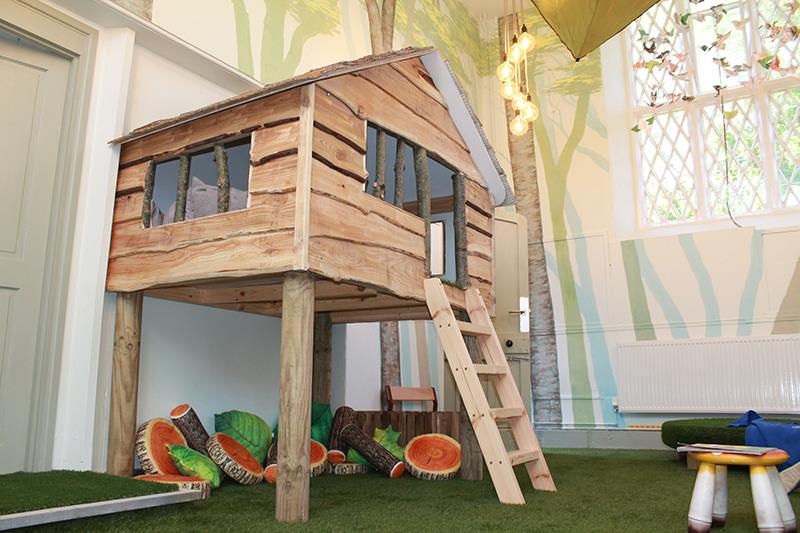
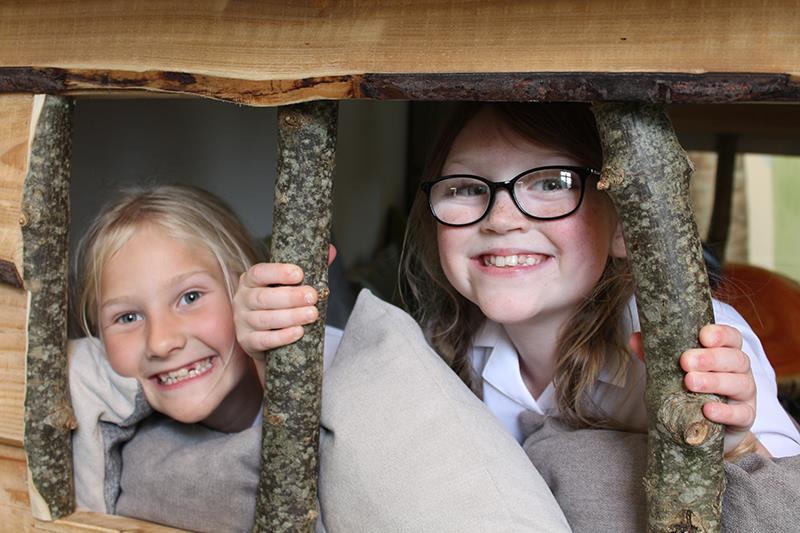
Elsewhere, plain stools were purchased and spray painted as toadstools to reflect the woodland theme and beneath a two-leaved canopy we installed a bookshelf containing a selection of non-fiction books. We have affectionately nicknamed this space “Narnia Corner”.
A mini-picnic bench and curved wooden bench were purchased to provide alternative seating. In addition, a repurposed old wooden cable reel (otherwise a waste product) has been revamped to provide a secure base for our tree, as well as seating/desk space for children.
The mural
The beautiful artwork that adorns our walls was painted by local artist Jamie Whyte. We were keen to invest in artwork by a local artist and, having reviewed his portfolio, we were confident that he could produce something special. The remit was to use the ash trees as a point of reference for a floor to ceiling mural of trees around the room. The colours used echo the palette used for the background paint.
A sensory experience
To give our children a sensory experience and bring the outdoors indoors, we were keen to lay artificial grass instead of carpet. It works well aesthetically and acoustically and is a real statement. Our pupils with sensory needs are responding particularly well to the environment.
Secreted on the top shelves is a bamboo diffuser, containing essential oils to permeate throughout the room, as recommended by one of our parents who is a qualified aromatherapist. Orange functions as a mood booster, woody juniper is calming and grounding, while bergamot is uplifting and refreshing.
Finishing touches and furnishings
We were keen to furnish the room with various points of interest. Running along the shelf edges there are inspirational quotes from texts and writers made using wooden letters.
Elsewhere, we wanted the colour green to be a prevalent feature in the room so we have used sails to add colour and warmth, while also making the space more intimate and without compromising the mural details on the walls.
We love the idea of children having flexibility in choosing where they would like to sit to read. The cushions make it possible for children to sit comfortably wherever they like. A parent created envelope cushion covers from material donated by a local mattress company. Woodland-themed cushions that usually live beneath the treehouse were sourced online.
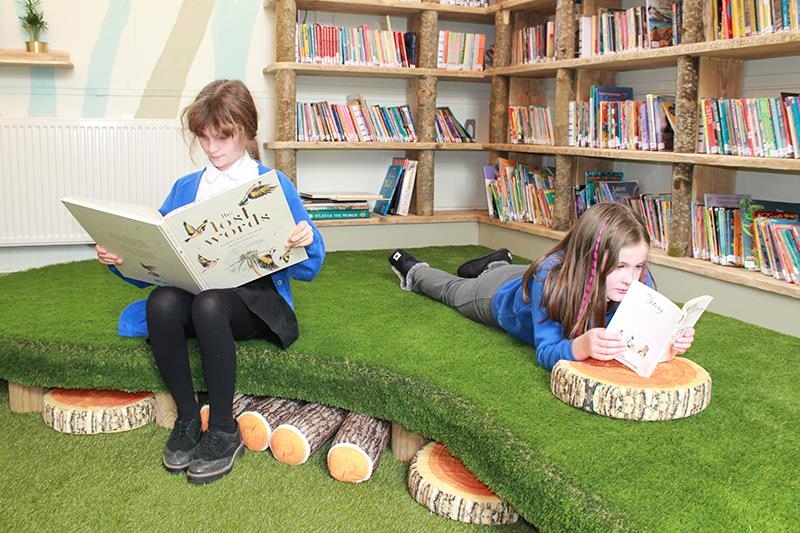
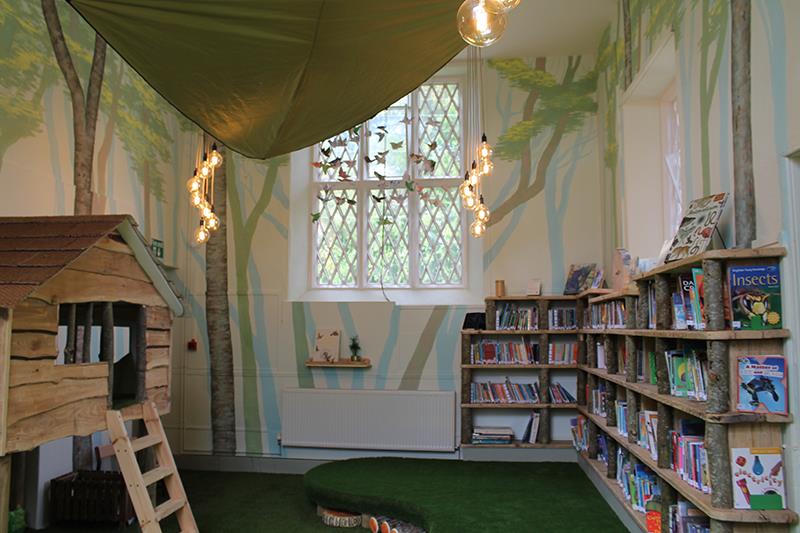
Inspired by nature and keen to get our children involved with the project, one parent suggested creating a “murmuration” of origami birds to feature in our library. With a team of parent helpers leading the activity, every child in school created an origami bird. They have been suspended with fishing wire from locally sourced twisted willow branches.
Our very low energy lighting is dimmable, with a warm white colour to make our library glow. This creates a lovely environment for our children and staff. The lighting will consume half the energy of the old library lighting, which will save the school money in electricity costs.
Other touches include:
- Our numberless clock is made from oiled and locally sourced wood, with mechanisms attached.
- We wanted a space to showcase books, to celebrate and inspire our children, so we included a small floating shelf on one of the walls.
- In the corner of our library is a ficus benjamina tree, highly recommended by a friend of the school (and a former head gardener at London’s Kew Gardens). It is known to be quite a hardy tree, and we hope it will grow to four metres in height.
- We installed USB plug sockets and leads which link to tablets in sustainably sourced bamboo tablet holders. These will be used for children to quiz on when they complete their Accelerated Reader books. We wanted to minimise digital technology in our library and maximise opportunities for children to develop a love of reading books.
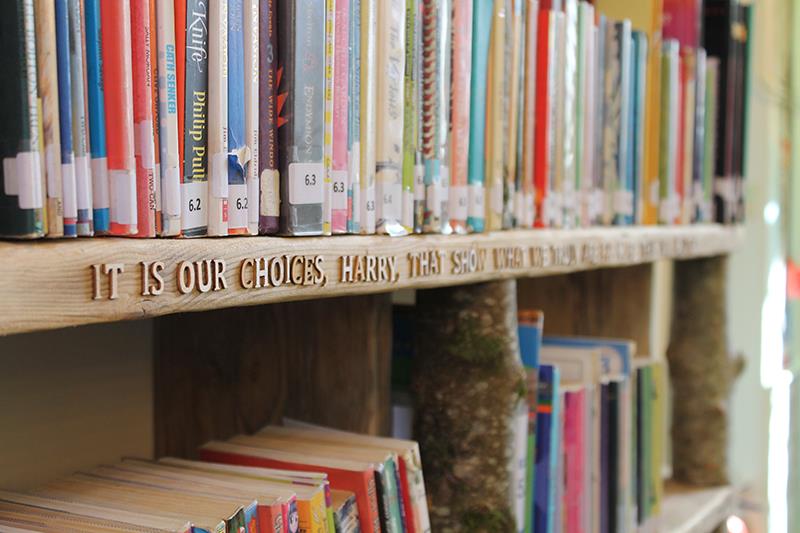
Shirley’s Library
Our library is called Shirley’s Library, named after a dedicated teaching assistant who recently retired after working at the school for 43 years. She is a passionate advocate of reading, so it was a fitting tribute. The library took approximately 200 hours of labour from 21 adults, 12 of whom were parents, and most of whom volunteered their time. The result? Well, this library could change everything. And I mean everything.
- Christine Campion is head of teaching and learning and the SENDCO at Halberton Primary School in Halberton, Devon.
